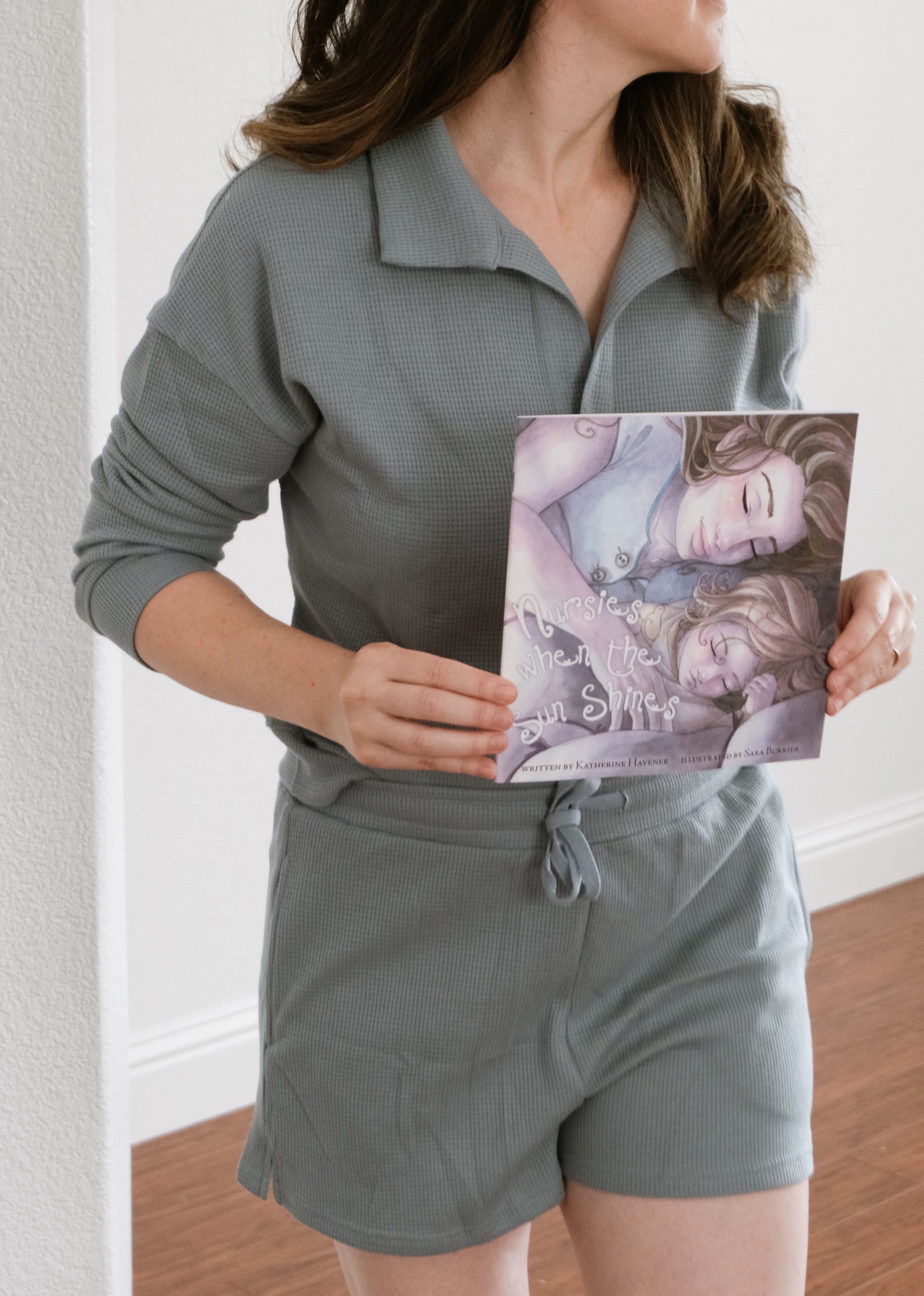Most bedsharing parents use breastfeeding as a tool to help their baby fall asleep quickly and easily. It’s daunting to wonder how you’ll help them to sleep when you stop nursing them. But with the help of a night weaning book, it is possible to bedshare without breastfeeding your toddler throughout the night.
The best way to stop nursing your bedsharing toddler throughout the night is to read them the night weaning book Nursies When the Sun Shines. The book will teach them that breastfeeding only happens in the daytime, not at night while you cosleep.
There are other books on this topic, but Nursies When the Sun Shines includes instructions for parents in the back! It is the gold standard.
When You Need a Night Weaning Book
There are many reasons a mom may decide she’s ready to night wean her toddler or big kid. Let’s take a closer look at some of the main reasons.


loungewear | slippers | night weaning book (paperback)
Why Do Some Bedsharing Parents Decide to Night Wean?
- They simply don’t want to breastfeed at night any longer
- They’re returning to work
- They’re going into the hospital or beginning medication
- They’re experiencing nursing aversion
- They’re pregnant or adjusting to a new baby
Many parents believe that their toddler will sleep through the night once they’re not waking up to nurse. (Unfortunately, data doesn’t support this theory.) So when they need to return to the workplace after maternity leave, they night wean in hopes of getting more hours of sleep, but they continue bedsharing so that reconnect after long workdays apart.
Other parents return to shift work and will need to work during the night. In this case, night weaning is necessary so that the other parent can bedshare with the toddler during the night. In some cases, some moms choose to pump breastmilk so that the other parent can feed it to the toddler in a cup or bottle during the night.
Some bedsharing parents unexpectedly go into the hospital for treatment and/or get diagnosed with something and begin medication. In these cases, they realize that they need to night wean because it won’t be safe to continue breastfeeding.
Anytime you’re bedsharing on medication, consult with your doctor and The Breastfeeding Family’s Guide to Nonprescription Drugs and Everyday Products.
What is Breastfeeding Aversion and Agitation?
Nursing aversion leads many moms to feel guilt and shame about breastfeeding, and they ultimately decide to night wean.
It is characterised by feelings of anger or rage, a skin crawling sensation and an urge to remove the suckling infant, but can also be feelings of agitation and irritability whilst the infant is latched. A number of mothers who experience aversion still continue to breastfeed, but have feelings of guilt and shame while also experiencing confusion around those feelings.
Zainab M. Yate
Studies on Breastfeeding Aversion and Agitation (BAA) have found that while severity, duration, and form vary, women all over the world share this phenomenon. Mothers describe very similar feelings and thoughts, often using the exact same phrases.
Nursing aversion commonly occurs when a breastfeeding mother becomes pregnant. Maybe your body cannot fulfill the demands of gestation and lactation, so it becomes physically painful. Or maybe you were able to comfortably nurse your toddler throughout your pregnancy, but now that they new baby’s arrived, it’s not working logistically and you need to night wean.
When Your Toddler Needs a Night Weaning Book
Night weaning is a major event in your little one’s life, and it should not be taken lightly. It’s important that you wait until your toddler is emotionally and physically ready to stop nursing throughout the night.
Toddlers who wake at night to nurse are typically incredibly attached to nursing; moreover, to the comfort and love that they get from mother while nursing at the breast. Weaning before a child is ready can cause a great deal of fear, sadness and anxiety in a little person. Thus, night weaning — like any weaning from breastfeeding — needs to be done very gently, and gradually, and with the utmost compassion and love.
Katherine Havener
I don’t recommend night weaning before 12 months. Human infants are biologically designed to drink breastmilk day and night, throughout their first year of life.
Personally, I didn’t think my boys were ready to be night weaned until about 18 months. That’s when they could understand the Why behind this huge transition.
Through word of mouth, I heard about a picture book called Nursies When the Sun Shines. The story is simple, and the watercolor illustrations are gorgeous. Both of my little boys reach for it time and time again, and it always leaves my heart full.



night weaning book (board book)
The Best Night Weaning Book for Bedsharing Families
The book has a simple message: daytime is for nursing and nighttime is for sleeping.
I felt like the author, Katherine Havener, held my hand through the process. She left detailed instructions on the last page of the book, ensuring any apprehensive parent is able to do it gently and compassionately.
There’s no question about it, nursing a toddler is wonderful. It creates a beautiful bond between a mother and child, and it helps ease oh-so-many of those little person woes. For mothers whose toddlers wake up frequently at night to nurse, it can also be exhausting. At some point in the relationship, a mother may wish to night wean her child. It is for this mother that this book was written. This book will help a mother teach her child — through beautiful words and illustrations — that s/he should nurse during the day and sleep at night.
Katherine Havener
As soon as the book arrived on our porch, I tore open the envelope and read it to Cubby. I substituted “nursies” for our special word for milk.
We read it each night before bed for four weeks. Each night, I would ask him questions about the simple story, to gauge his understanding of the concept that nursing is only for daytime.
By the end of the month, he could tell me the story in his own words as I turned the pages.
When I Knew the Night Weaning Book Had Done Its Job
When I felt like we were both ready, I told him that tomorrow we would begin. My milk would fall asleep with him at night and would be asleep until the sun came up.
That night, I wore a sweatshirt to bed instead of my usual nursing cami. When Cubby reached for me and realized he didn’t have easy access to breastfeeding, I reminded him that the milk was asleep.
I had been hopeful, optimistic. But I was still incredibly shocked at my son’s reaction. He nodded, assumed the little spoon position, and fell back asleep within a minute or two.
He didn’t cry, he didn’t beg, he didn’t ask more questions because we had talked about this scenario every single day for the last month.

night weaning book (board book)
I Couldn’t Have Done It Without This Night Weaning Book
How could I have made the process of night weaning slow, respectful, and nurturing on my own, without this book? I do not know; I am so thankful for it.
And even more, I love having it in our library because it is the only book we have that celebrates safe bedsharing.
The family at the heart of the story is made up of a mom, dad, toddler, and cat who sleep together in a big, cozy bed each night. It feels normal, and none of the book’s few words are spent trying to justify it.
This book will remain on our shelf for years to come.
I want my children to see that there are other babies out there who never touched a crib. And I want any friends or family who scan my bookshelf to realize that in this house, we are not ashamed of bedsharing.
Here, in the middle of the night, in an often scary world — we huddle together. No matter what comes, no matter how old they are, we will tell our children that our bedroom door is always open and we will “hold you and love you while you drift back to sleep.”
Disclaimer: If you make a purchase through an affiliate link, I may receive a small commission at no additional cost to you.





